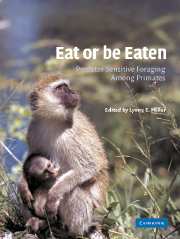Book contents
- Frontmatter
- Contents
- List of contributors
- Preface
- 1 An introduction to predator sensitive foraging
- PART I BIOLOGICAL VARIABLES
- PART II SOCIAL VARIABLES
- 6 The role of group size in predator sensitive foraging decisions for wedge-capped capuchin monkeys (Cebus olivaceus)
- 7 Group size effects on predation sensitive foraging in wild ring-tailed lemurs (Lemur catta)
- 8 Species differences in feeding in Milne Edward's sifakas (Propithecus diadema edwardsi), rufus lemurs (Eulemur fulvus rufus), and red-bellied lemurs (Eulemur rubiventer) in southern Madagascar: Implications for predator avoidance
- 9 Evidence of predator sensitive foraging and traveling in single- and mixed-species tamarin troops
- 10 Predator (in)sensitive foraging in sympatric female vervets (Cercopithecus aethiops) and patas monkeys (Erythrocebus patas): A test of ecological models of group dispersion
- 11 Predation risk and antipredator adaptations in whitefaced sakis, Pithecia pithecia
- PART III ENVIRONMENTAL VARIABLES
- Index
10 - Predator (in)sensitive foraging in sympatric female vervets (Cercopithecus aethiops) and patas monkeys (Erythrocebus patas): A test of ecological models of group dispersion
Published online by Cambridge University Press: 10 November 2009
- Frontmatter
- Contents
- List of contributors
- Preface
- 1 An introduction to predator sensitive foraging
- PART I BIOLOGICAL VARIABLES
- PART II SOCIAL VARIABLES
- 6 The role of group size in predator sensitive foraging decisions for wedge-capped capuchin monkeys (Cebus olivaceus)
- 7 Group size effects on predation sensitive foraging in wild ring-tailed lemurs (Lemur catta)
- 8 Species differences in feeding in Milne Edward's sifakas (Propithecus diadema edwardsi), rufus lemurs (Eulemur fulvus rufus), and red-bellied lemurs (Eulemur rubiventer) in southern Madagascar: Implications for predator avoidance
- 9 Evidence of predator sensitive foraging and traveling in single- and mixed-species tamarin troops
- 10 Predator (in)sensitive foraging in sympatric female vervets (Cercopithecus aethiops) and patas monkeys (Erythrocebus patas): A test of ecological models of group dispersion
- 11 Predation risk and antipredator adaptations in whitefaced sakis, Pithecia pithecia
- PART III ENVIRONMENTAL VARIABLES
- Index
Summary
Introduction
Competitive relationships result from competitive interactions over resources that can affect survival and reproduction. For male mammals, prospective mates are one such resource. For female mammals, food is more important than mates as a contestable resource (Trivers 1972). Its importance has been recognized by three ecological models that invoke either food distribution (van Schaik 1989, Wrangham 1980) or both food distribution and abundance (Isbell 1991) to explain variation in competitive relationships within and between groups of female primates (see also Isbell and Van Vuren 1996, Sterck et al. 1997, van Hooff and van Schaik 1992, Wrangham 1987). For both sexes, survival is also affected by other factors, such as disease and predation, and it is possible that individuals also compete for resources that in some way minimize exposure to disease or predators. In fact, one of the three models (here called the ‘predation hypothesis’) considers predation to be more important than food in its effects on the grouping behavior of females (van Schaik 1989).
The predation hypothesis assumes that predation ultimately forces females to live together and that variation in predation pressure causes variation in spatial cohesion within groups and among species (Sterck et al. 1997, van Hooff and van Schaik 1992, van Schaik 1989). Where predation pressure is high, females are predicted to decrease interindividual distances and thus live in groups that are spatially cohesive.
- Type
- Chapter
- Information
- Eat or be EatenPredator Sensitive Foraging Among Primates, pp. 154 - 168Publisher: Cambridge University PressPrint publication year: 2002
- 10
- Cited by



